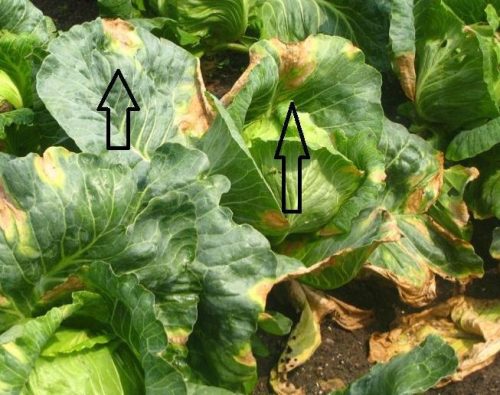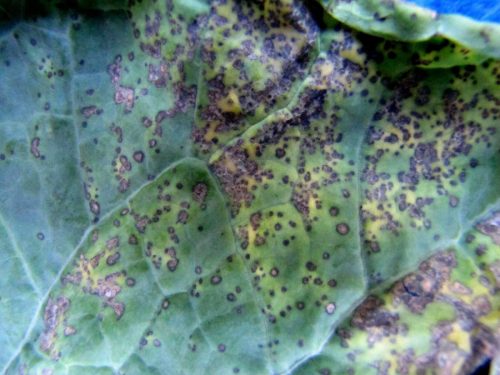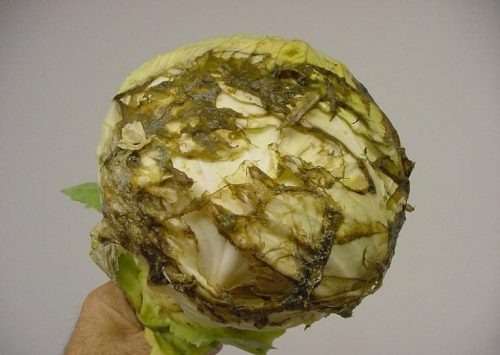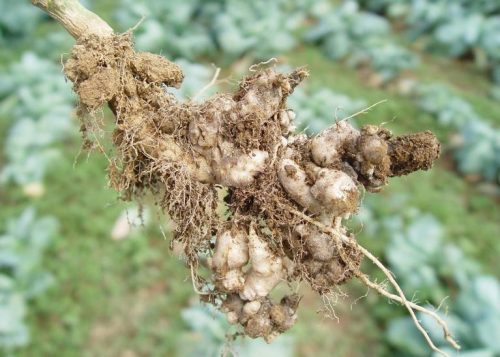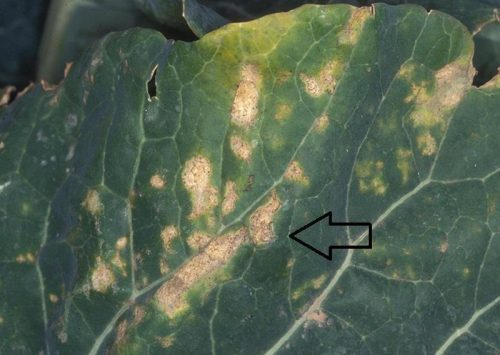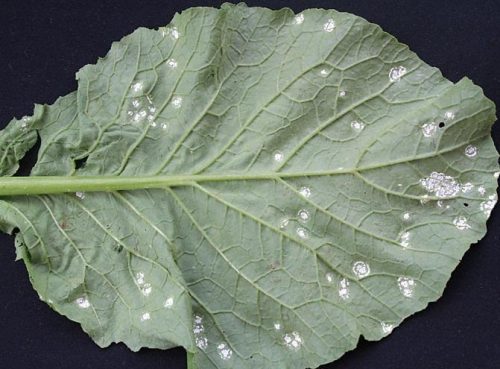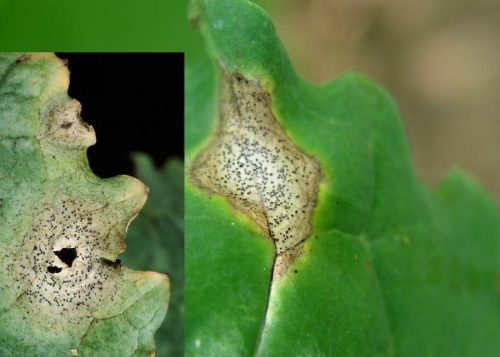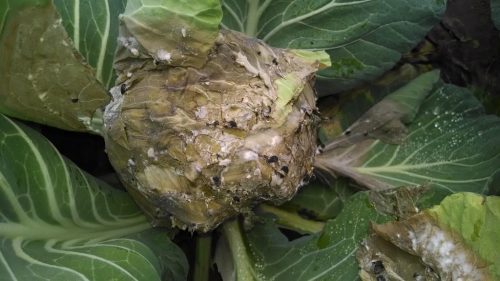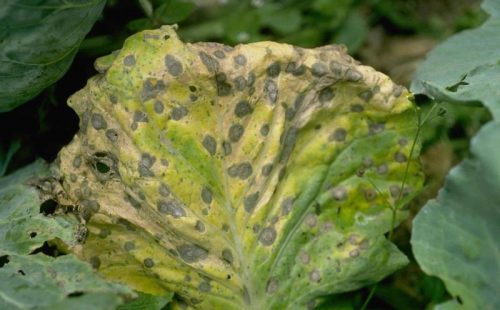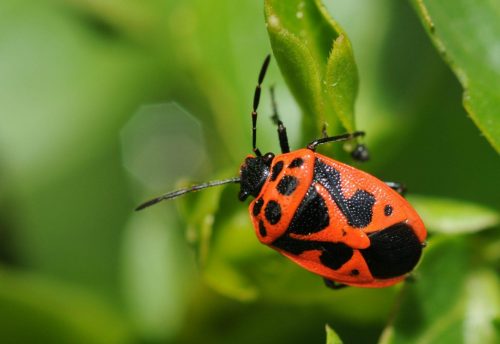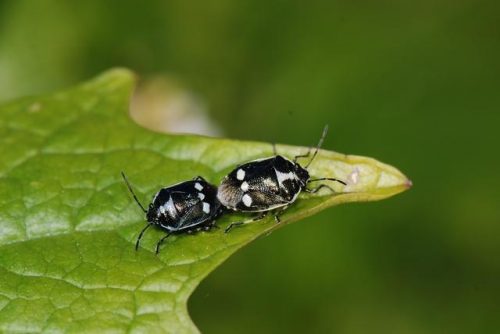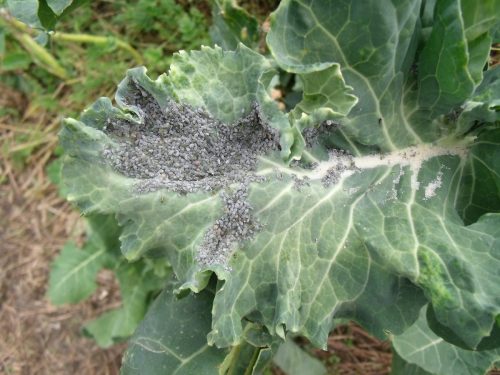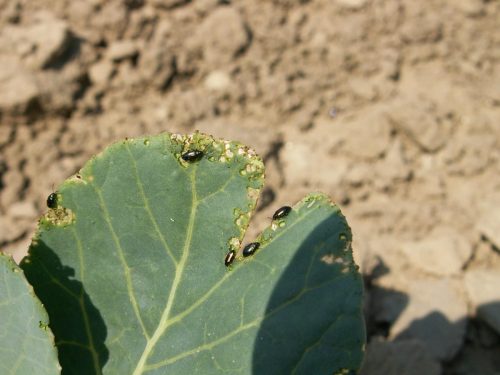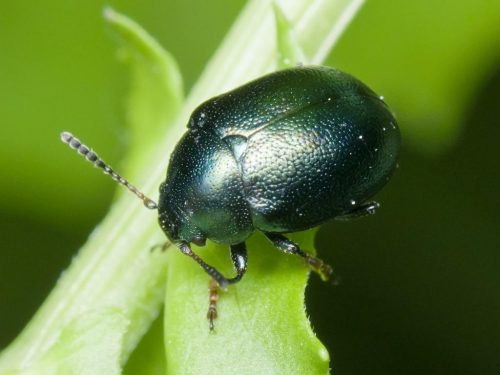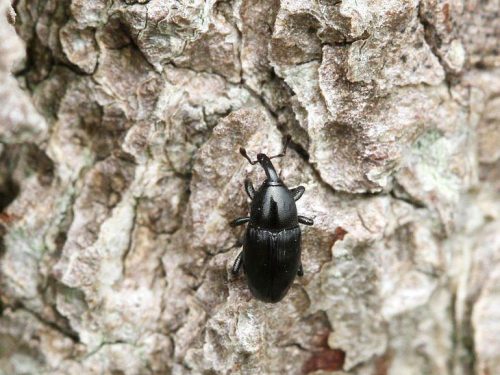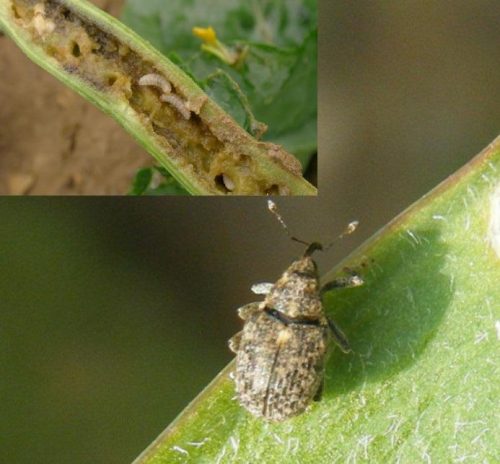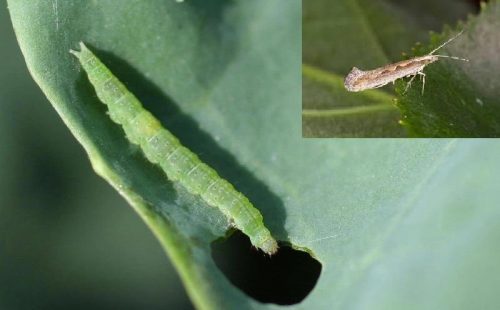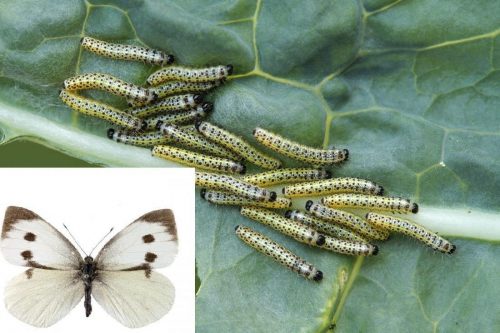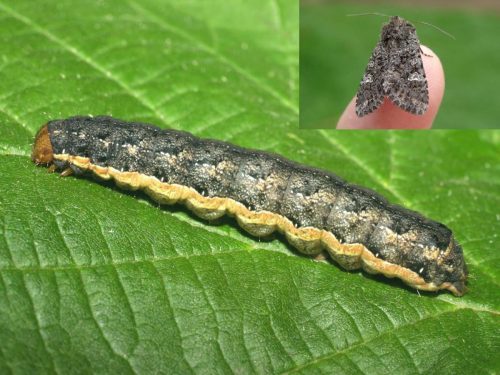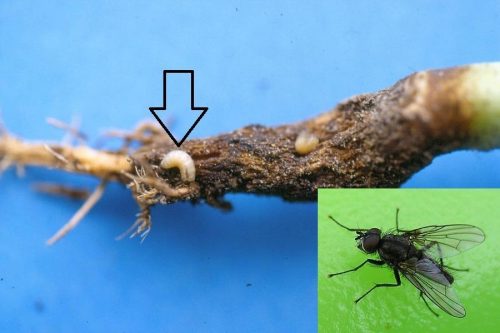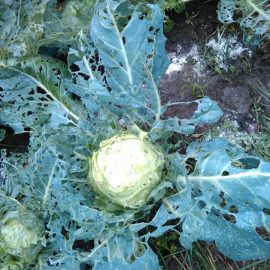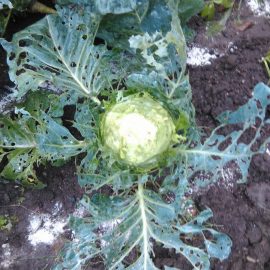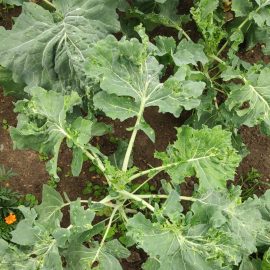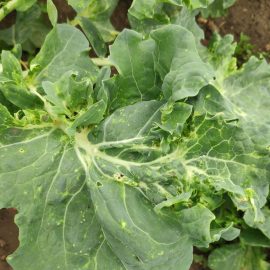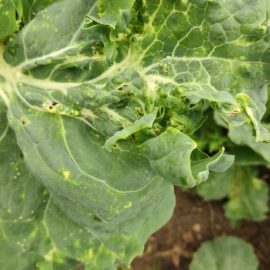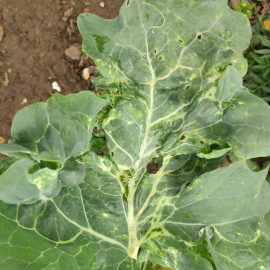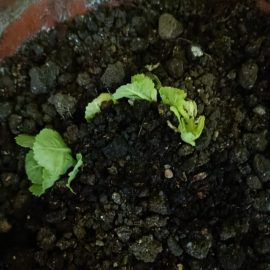Cabbage, treatments against pests and diseases
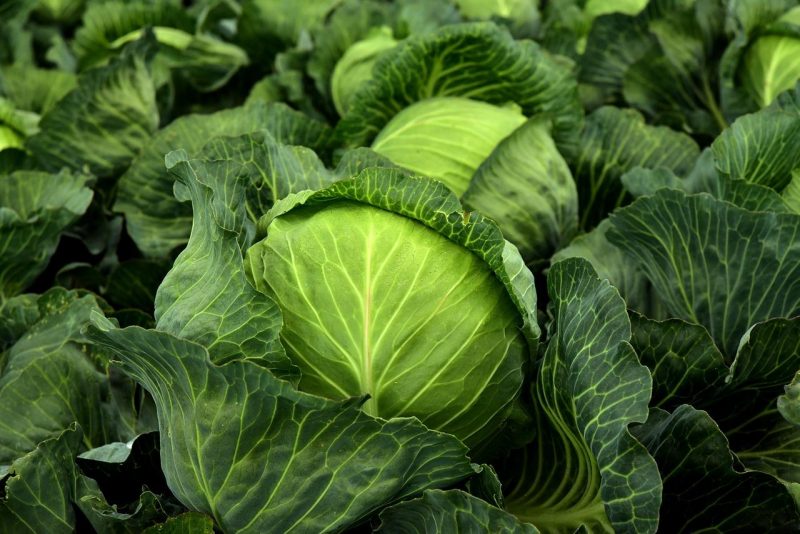
Cabbage (Brassica oleracea convar. capitata) is a biennial plant, belonging to the Brassicaceae family, cultivated for its heads which are used in human food, fresh, processed, or preserved. This plant is native to the Mediterranean basin, where it was cultivated by the Greeks and Romans. The cabbage is not demanding to environmental factors and can withstand temperatures as low as -3℃ during the sprouting phase. Thanks to the volatile substances it contains, cabbage has a bacteriostatic effect and in winter it is an important source of vitamins and minerals. Cabbage crops can be affected by pests and diseases, against which it’s important to apply the right treatments.
THE MAIN DISEASES OF CABBAGE
Bacteriosis
Black rot (Xanthomonas campestris)
Large, irregular, yellow spots appear on the leaves, along which the veins are browned and blackened. The tissues around the spots become parchment-like, thinned and eventually dry out. The disease develops rapidly in conditions of high humidity. By cross-sectioning through the stem, you can see the browned vessels. The disease is transmitted by infected seed and bacterial exudate, which is carried by water droplets and slugs.
Prevention and control measures:
- disinfecting the seed and seedling substrate before sowing;
- growing resistant varieties;
- correct rotation (cabbage should not return to the same land for 4 years);
- collecting and destroying plant debris after harvest;
- cabbage treatments with copper-based fungicides.
Cabbage leaf spot (Pseudomonas syringae pv. maculicola)
The infection manifests as small, dark, moist spots on both sides of the leaves. These spots usually remain small but can spread if conditions are favorable. Sometimes a purple border may appear on older spots. Severe infections can lead to premature leaf drop.
Prevention and control measures:
- avoiding sprinkler watering;
- using healthy seeds and seedlings;
- cabbage treatments with specific fungicides.
Soft rot (Erwinia carotovora pv. carotovora)
The attack occurs in rainy years when the soil is compacted. Moist, yellowish spots appear in the leaf attachment area. In conditions of high atmospheric humidity, the rot covers the entire head and turns it into a foul-smelling, mucilaginous mass. The bacterium lives on plant debris on the soil surface and infected seeds. The attack can also occur in the storage room if temperatures are kept around 20-25℃.
Prevention and control measures:
- gathering and destroying plant debris after harvesting;
- disinfecting seeds and seedling substrate;
- correct rotation (cabbage should not return to the same land for 4 years);
- sorting the cabbage heads before storage;
- cabbage treatments with specific fungicides.
Mycosis
Clubroot (Plasmodiophora brassicae)
It is an easily recognizable disease because of the symptoms that appear on the leaves and roots. Aerial symptoms are represented by plant dwarfing, leaf yellowing, and wilting. On the roots the disease manifests by the appearance of swellings or strangulations, indicating a dysfunctional root system. The disease can appear from the seedling stage.
Prevention and control measures:
- checking the seedlings before planting;
- choosing soils with a slightly basic pH when planting;
- removing diseased plants from the crop;
- correct rotation (cabbage can return to the same land after 3-4 years).
Downy mildew (Peronospora brassicae)
The disease frequently occurs in plants grown at higher densities and is favored by high humidity conditions. The first symptoms are represented by irregular yellow spots on the leaves, which later turn brown. On the underside, opposite these spots, a greyish-white fuzz appears. Under high humidity conditions, the infection spreads rapidly, the leaves rot or dry out, and plant growth is stopped.
Prevention and control measures:
- using resistant varieties;
- removing attacked plants from the crop;
- cabbage treatments with specific fungicides.
Recommended products
-
You can find products on a different store
Change Store -
You can find products on a different store
Change Store -
You can find products on a different store
Change Store -
You can find products on a different store
Change Store -
You can find products on a different store
Change Store -
You can find products on a different store
Change Store -
You can find products on a different store
Change Store -
You can find products on a different store
Change Store -
You can find products on a different store
Change Store -
You can find products on a different store
Change Store -
You can find products on a different store
Change Store -
You can find products on a different store
Change Store -
You can find products on a different store
Change Store -
You can find products on a different store
Change Store -
You can find products on a different store
Change Store -
You can find products on a different store
Change Store -
You can find products on a different store
Change Store -
You can find products on a different store
Change Store -
You can find products on a different store
Change Store -
You can find products on a different store
Change Store -
You can find products on a different store
Change Store -
You can find products on a different store
Change Store -
You can find products on a different store
Change Store -
You can find products on a different store
Change Store
White rust of crucifers (Albugo candida)
The disease can appear in the early stages of vegetation. Yellowish discoloration spots of various shapes appear on the plant’s parts and white-milky, ring-shaped crusts form on both sides of the leaves. As the disease progresses, the skin cracks, and the spots become powdery. The spots merge and the leaves dry out. Symptoms may also appear on the stem. After the attack, the stem thickens, bends and twists, and finally withers.
Prevention and control measures:
- weed control;
- correct rotation (cabbage can return to the same field after 3-4 years);
- gathering and destroying plant debris after harvest;
- cabbage treatments with specific fungicides.
Recommended products
-
You can find products on a different store
Change Store -
You can find products on a different store
Change Store -
You can find products on a different store
Change Store -
You can find products on a different store
Change Store -
You can find products on a different store
Change Store -
You can find products on a different store
Change Store -
You can find products on a different store
Change Store -
You can find products on a different store
Change Store -
You can find products on a different store
Change Store -
You can find products on a different store
Change Store -
You can find products on a different store
Change Store -
You can find products on a different store
Change Store -
You can find products on a different store
Change Store -
You can find products on a different store
Change Store -
You can find products on a different store
Change Store -
You can find products on a different store
Change Store -
You can find products on a different store
Change Store -
You can find products on a different store
Change Store -
You can find products on a different store
Change Store -
You can find products on a different store
Change Store -
You can find products on a different store
Change Store -
You can find products on a different store
Change Store -
You can find products on a different store
Change Store -
You can find products on a different store
Change Store
Blackleg disease (Phoma lingam)
The disease attacks the aerial parts of the plant. The first symptoms are discolored spots, on which small black dots appear, representing the fungus’ fructifications. In case of a severe attack, the plant may be defoliated or destroyed. The fungus survives on plant debris and is transmitted by several vectors (water, wind, animals, humans).
Prevention and control measures:
- gathering and destroying plant debris after harvesting;
- planting healthy seedlings;
- growing resistant cabbage varieties;
- cabbage treatments with specific fungicides.
Recommended products
-
You can find products on a different store
Change Store -
You can find products on a different store
Change Store -
You can find products on a different store
Change Store -
You can find products on a different store
Change Store -
You can find products on a different store
Change Store -
You can find products on a different store
Change Store -
You can find products on a different store
Change Store -
You can find products on a different store
Change Store -
You can find products on a different store
Change Store -
You can find products on a different store
Change Store -
You can find products on a different store
Change Store -
You can find products on a different store
Change Store -
You can find products on a different store
Change Store -
You can find products on a different store
Change Store -
You can find products on a different store
Change Store -
You can find products on a different store
Change Store -
You can find products on a different store
Change Store -
You can find products on a different store
Change Store -
You can find products on a different store
Change Store -
You can find products on a different store
Change Store -
You can find products on a different store
Change Store -
You can find products on a different store
Change Store -
You can find products on a different store
Change Store -
You can find products on a different store
Change Store
White mold (Sclerotinia sclerotiorum )
The disease sets in on leaves that come into contact with the soil or on the stem. In case of a severe attack, the whole head becomes covered with a watery rot, accompanied by a white fuzz. Black sclerotia develop on the affected tissues, representing the fungus fructifications. The attacked tissues soften and turn brown. The fungus survives during the winter as sclerotia.
Prevention and control measures:
- gathering and destroying plant debris after harvest;
- removing affected plants from the crop;
- avoiding sprinkler irrigation;
- balanced fertilization;
- disinfecting seeds and hotbed substrate;
- cabbage treatments with specific fungicides.
Recommended products
-
You can find products on a different store
Change Store -
You can find products on a different store
Change Store -
You can find products on a different store
Change Store -
You can find products on a different store
Change Store -
You can find products on a different store
Change Store -
You can find products on a different store
Change Store -
You can find products on a different store
Change Store -
You can find products on a different store
Change Store -
You can find products on a different store
Change Store -
You can find products on a different store
Change Store -
You can find products on a different store
Change Store -
You can find products on a different store
Change Store -
You can find products on a different store
Change Store -
You can find products on a different store
Change Store -
You can find products on a different store
Change Store -
You can find products on a different store
Change Store -
You can find products on a different store
Change Store -
You can find products on a different store
Change Store -
You can find products on a different store
Change Store -
You can find products on a different store
Change Store -
You can find products on a different store
Change Store -
You can find products on a different store
Change Store -
You can find products on a different store
Change Store -
You can find products on a different store
Change Store
Dark spot of crucifers (Alternaria brassicae)
The disease manifests as circular, brown spots on leaves and petioles. The spots evolve, enlarge, then become surrounded by a yellow border. Affected tissues dry out and fall off. The disease favors the appearance of fungal or bacterial rots.
Prevention and control measures:
- correct crop rotation (cabbage can return to the same land after 3-4 years);
- disinfection of seeds and hotbed substrate.
- avoiding sprinkler irrigation;
- cabbage treatments with specific fungicides.
Recommended products
-
You can find products on a different store
Change Store -
You can find products on a different store
Change Store -
You can find products on a different store
Change Store -
You can find products on a different store
Change Store -
You can find products on a different store
Change Store -
You can find products on a different store
Change Store -
You can find products on a different store
Change Store -
You can find products on a different store
Change Store -
You can find products on a different store
Change Store -
You can find products on a different store
Change Store -
You can find products on a different store
Change Store -
You can find products on a different store
Change Store -
You can find products on a different store
Change Store -
You can find products on a different store
Change Store -
You can find products on a different store
Change Store -
You can find products on a different store
Change Store -
You can find products on a different store
Change Store -
You can find products on a different store
Change Store -
You can find products on a different store
Change Store -
You can find products on a different store
Change Store -
You can find products on a different store
Change Store -
You can find products on a different store
Change Store -
You can find products on a different store
Change Store -
You can find products on a different store
Change Store
THE MAIN PESTS OF CABBAGE
Cabbage bug (Eurydema ornata)
It has 1-2 generations per year and overwinters as an adult under the leaves of trees. Adults appear early in spring, feed on spontaneous crucifers, then lay their clustered eggs on the underside of the leaves of cauliflower, cabbage, brussels sprouts, etc. Adults and larvae sting and suck sap from tissues, causing necrosis.
Control measures:
- balanced fertilization;
- weed control;
- chemical treatments with specific insecticides.
Recommended products
-
You can find products on a different store
Change Store -
You can find products on a different store
Change Store -
You can find products on a different store
Change Store -
You can find products on a different store
Change Store -
You can find products on a different store
Change Store -
You can find products on a different store
Change Store -
You can find products on a different store
Change Store -
You can find products on a different store
Change Store -
You can find products on a different store
Change Store -
You can find products on a different store
Change Store -
You can find products on a different store
Change Store -
You can find products on a different store
Change Store -
You can find products on a different store
Change Store -
You can find products on a different store
Change Store -
You can find products on a different store
Change Store -
You can find products on a different store
Change Store -
You can find products on a different store
Change Store -
You can find products on a different store
Change Store -
You can find products on a different store
Change Store -
You can find products on a different store
Change Store -
You can find products on a different store
Change Store -
You can find products on a different store
Change Store -
You can find products on a different store
Change Store -
You can find products on a different store
Change Store
The crucifer shield bug (Eurydema oleracea)
It has 1-2 generations per year and overwinters as an adult on the plant debris left after harvest. Adults emerge in spring and begin to feed, laying their eggs on leaf petioles, stems, etc. Larvae are similar to adults. Adults and larvae attack all aerial organs of the plant. The attacked tissues become necrotic and the plant ceases to develop normally.
Control measures:
- balanced fertilization;
- weed control;
- specific insecticide treatments.
Recommended products
-
You can find products on a different store
Change Store -
You can find products on a different store
Change Store -
You can find products on a different store
Change Store -
You can find products on a different store
Change Store -
You can find products on a different store
Change Store -
You can find products on a different store
Change Store -
You can find products on a different store
Change Store -
You can find products on a different store
Change Store -
You can find products on a different store
Change Store -
You can find products on a different store
Change Store -
You can find products on a different store
Change Store -
You can find products on a different store
Change Store -
You can find products on a different store
Change Store -
You can find products on a different store
Change Store -
You can find products on a different store
Change Store -
You can find products on a different store
Change Store -
You can find products on a different store
Change Store -
You can find products on a different store
Change Store -
You can find products on a different store
Change Store -
You can find products on a different store
Change Store -
You can find products on a different store
Change Store -
You can find products on a different store
Change Store -
You can find products on a different store
Change Store -
You can find products on a different store
Change Store
Cabbage aphid (Brevicoryne brassicae)
This species attacks all plants belonging to the Brassicaceae family. It develops several generations per year and overwinters as an egg on plant debris on the soil surface. In early spring, colonies appear on wild crucifers, and in June winged forms migrate to cultivated crucifers. Adults and larvae sting the plant parts and feed on their sap. As a result, the leaves become shriveled and in case of a strong attack, they dry up and fall off.
Control measures:
- weed control;
- using sticky traps;
- cabbage treatments with specific insecticides.
Recommended products
-
You can find products on a different store
Change Store -
You can find products on a different store
Change Store -
You can find products on a different store
Change Store -
You can find products on a different store
Change Store -
You can find products on a different store
Change Store -
You can find products on a different store
Change Store -
You can find products on a different store
Change Store -
You can find products on a different store
Change Store -
You can find products on a different store
Change Store -
You can find products on a different store
Change Store -
You can find products on a different store
Change Store -
You can find products on a different store
Change Store -
You can find products on a different store
Change Store -
You can find products on a different store
Change Store -
You can find products on a different store
Change Store -
You can find products on a different store
Change Store -
You can find products on a different store
Change Store -
You can find products on a different store
Change Store -
You can find products on a different store
Change Store -
You can find products on a different store
Change Store -
You can find products on a different store
Change Store -
You can find products on a different store
Change Store -
You can find products on a different store
Change Store -
You can find products on a different store
Change Store
Flea beetles (Phyllotreta spp.)
Adults appear in early spring, and after additional feeding, they lay their eggs in the soil near cabbage plants, cauliflower, kohlrabi, etc. Adults attack the leaves, gnaw the tissues, giving the leaf a pitted appearance.
Control measures:
- deep autumn plowing and repeated hoeings;
- specific insecticide treatments.
Recommended products
-
You can find products on a different store
Change Store -
You can find products on a different store
Change Store -
You can find products on a different store
Change Store -
You can find products on a different store
Change Store -
You can find products on a different store
Change Store -
You can find products on a different store
Change Store -
You can find products on a different store
Change Store -
You can find products on a different store
Change Store -
You can find products on a different store
Change Store -
You can find products on a different store
Change Store -
You can find products on a different store
Change Store -
You can find products on a different store
Change Store -
You can find products on a different store
Change Store -
You can find products on a different store
Change Store -
You can find products on a different store
Change Store -
You can find products on a different store
Change Store -
You can find products on a different store
Change Store -
You can find products on a different store
Change Store -
You can find products on a different store
Change Store -
You can find products on a different store
Change Store -
You can find products on a different store
Change Store -
You can find products on a different store
Change Store -
You can find products on a different store
Change Store -
You can find products on a different store
Change Store
Leaf beetle (Colaphellus sophiae)
It has several generations per year and overwinters as an adult in the soil. It causes damage in the larval and adult stages, destroying young leaves. At maturity, the larvae retreat into the topsoil where they pupate.
Control measures:
- autumn plowing and repeated hoeings;
- specific insecticide treatments.
Baris laticollis
It develops several generations per year and overwinters as an adult in the topsoil and under plant debris on the ground. Adults emerge in spring and, after additional feeding, lay their eggs in the leaf petiole or stem. Larvae gnaw feeding galleries in the petiole and stem.
Control measures:
- collecting and destroying plant debris after harvesting;
- deep autumn plowing;
- early planting;
- specific insecticide treatments.
Recommended products
-
You can find products on a different store
Change Store -
You can find products on a different store
Change Store -
You can find products on a different store
Change Store -
You can find products on a different store
Change Store -
You can find products on a different store
Change Store -
You can find products on a different store
Change Store -
You can find products on a different store
Change Store -
You can find products on a different store
Change Store -
You can find products on a different store
Change Store -
You can find products on a different store
Change Store -
You can find products on a different store
Change Store -
You can find products on a different store
Change Store -
You can find products on a different store
Change Store -
You can find products on a different store
Change Store -
You can find products on a different store
Change Store -
You can find products on a different store
Change Store -
You can find products on a different store
Change Store -
You can find products on a different store
Change Store -
You can find products on a different store
Change Store -
You can find products on a different store
Change Store -
You can find products on a different store
Change Store -
You can find products on a different store
Change Store -
You can find products on a different store
Change Store -
You can find products on a different store
Change Store
Cabbage stem weevil (Ceutorhynchus pallidactylus)
It has 1-3 generations per year and overwinters as an adult in the topsoil and under plant debris on the ground. Adults emerge in spring and lay their eggs in plant stems. Adults gnaw on leaves and larvae dig feeding galleries in the stem. In case of a strong attack, the stem breaks and the cabbage head falls to the ground.
Control measures:
- gathering and destroying plant debris after harvest;
- deep autumn plowing;
- early planting ;
- specific insecticide treatments.
Recommended products
-
You can find products on a different store
Change Store -
You can find products on a different store
Change Store -
You can find products on a different store
Change Store -
You can find products on a different store
Change Store -
You can find products on a different store
Change Store -
You can find products on a different store
Change Store -
You can find products on a different store
Change Store -
You can find products on a different store
Change Store -
You can find products on a different store
Change Store -
You can find products on a different store
Change Store -
You can find products on a different store
Change Store -
You can find products on a different store
Change Store -
You can find products on a different store
Change Store -
You can find products on a different store
Change Store -
You can find products on a different store
Change Store -
You can find products on a different store
Change Store -
You can find products on a different store
Change Store -
You can find products on a different store
Change Store -
You can find products on a different store
Change Store -
You can find products on a different store
Change Store -
You can find products on a different store
Change Store -
You can find products on a different store
Change Store -
You can find products on a different store
Change Store -
You can find products on a different store
Change Store
Diamondback moth (Plutella xylostella)
It has several generations per year and overwinters in the pupa stage in the soil or on various plant debris. Adults lay their eggs on the underside of the leaves. The larvae gnaw the epidermis and parenchyma, giving the leaves a leaden appearance.
Control measures:
- balanced fertilization;
- weed control;
- removing plant debris after harvest;
- chemical treatments with specific insecticides;
Recommended products
-
You can find products on a different store
Change Store -
You can find products on a different store
Change Store -
You can find products on a different store
Change Store -
You can find products on a different store
Change Store -
You can find products on a different store
Change Store -
You can find products on a different store
Change Store -
You can find products on a different store
Change Store -
You can find products on a different store
Change Store -
You can find products on a different store
Change Store -
You can find products on a different store
Change Store -
You can find products on a different store
Change Store -
You can find products on a different store
Change Store -
You can find products on a different store
Change Store -
You can find products on a different store
Change Store -
You can find products on a different store
Change Store -
You can find products on a different store
Change Store -
You can find products on a different store
Change Store -
You can find products on a different store
Change Store -
You can find products on a different store
Change Store -
You can find products on a different store
Change Store -
You can find products on a different store
Change Store -
You can find products on a different store
Change Store -
You can find products on a different store
Change Store -
You can find products on a different store
Change Store
Cabbage white butterfly (Pieris brassicae)
Larvae of the cabbage white butterfly attack cabbage, kohlrabi, radish, and other cultivated and wild crucifers. Early larvae feed in groups and gnaw the lower epidermis and parenchyma. Later, they become solitary and skeletonize the leaves.
Control measures:
- chemical treatments with specific insecticides.
Recommended products
-
You can find products on a different store
Change Store -
You can find products on a different store
Change Store -
You can find products on a different store
Change Store -
You can find products on a different store
Change Store -
You can find products on a different store
Change Store -
You can find products on a different store
Change Store -
You can find products on a different store
Change Store -
You can find products on a different store
Change Store -
You can find products on a different store
Change Store -
You can find products on a different store
Change Store -
You can find products on a different store
Change Store -
You can find products on a different store
Change Store -
You can find products on a different store
Change Store -
You can find products on a different store
Change Store -
You can find products on a different store
Change Store -
You can find products on a different store
Change Store -
You can find products on a different store
Change Store -
You can find products on a different store
Change Store -
You can find products on a different store
Change Store -
You can find products on a different store
Change Store -
You can find products on a different store
Change Store -
You can find products on a different store
Change Store -
You can find products on a different store
Change Store -
You can find products on a different store
Change Store
Cabbage moth (Mamestra brassicae)
The cabbage moth is a polyphagous pest, attacking cabbage, cauliflower, kohlrabi, and other cultivated and spontaneous crucifers. The caterpillars are located at the underside of the leaves, which they gnaw. The larvae gnaw holes in the leaves and dig galleries in the cabbage head. Phytopathogenic agents can settle on the wounds and cause the head to rot.
Control measures:
- cabbage treatments with specific insecticides.
Recommended products
-
You can find products on a different store
Change Store -
You can find products on a different store
Change Store -
You can find products on a different store
Change Store -
You can find products on a different store
Change Store -
You can find products on a different store
Change Store -
You can find products on a different store
Change Store -
You can find products on a different store
Change Store -
You can find products on a different store
Change Store -
You can find products on a different store
Change Store -
You can find products on a different store
Change Store -
You can find products on a different store
Change Store -
You can find products on a different store
Change Store -
You can find products on a different store
Change Store -
You can find products on a different store
Change Store -
You can find products on a different store
Change Store -
You can find products on a different store
Change Store -
You can find products on a different store
Change Store -
You can find products on a different store
Change Store -
You can find products on a different store
Change Store -
You can find products on a different store
Change Store -
You can find products on a different store
Change Store -
You can find products on a different store
Change Store -
You can find products on a different store
Change Store -
You can find products on a different store
Change Store
Cabbage root fly (Delia radicum)
They develop two generations per year and overwinter as larvae in the topsoil. The females lay their eggs in the soil near the plants. After hatching, the larvae penetrate the plants and form numerous feeding galleries. Attacked plants stop growing and gradually wither. By pulling an attacked plant out of the ground, numerous galleries or even larvae can be observed.
Control measures:
- deep autumn plowing;
- cabbage treatments with specific insecticides.














































































































































































































































































































































































































































